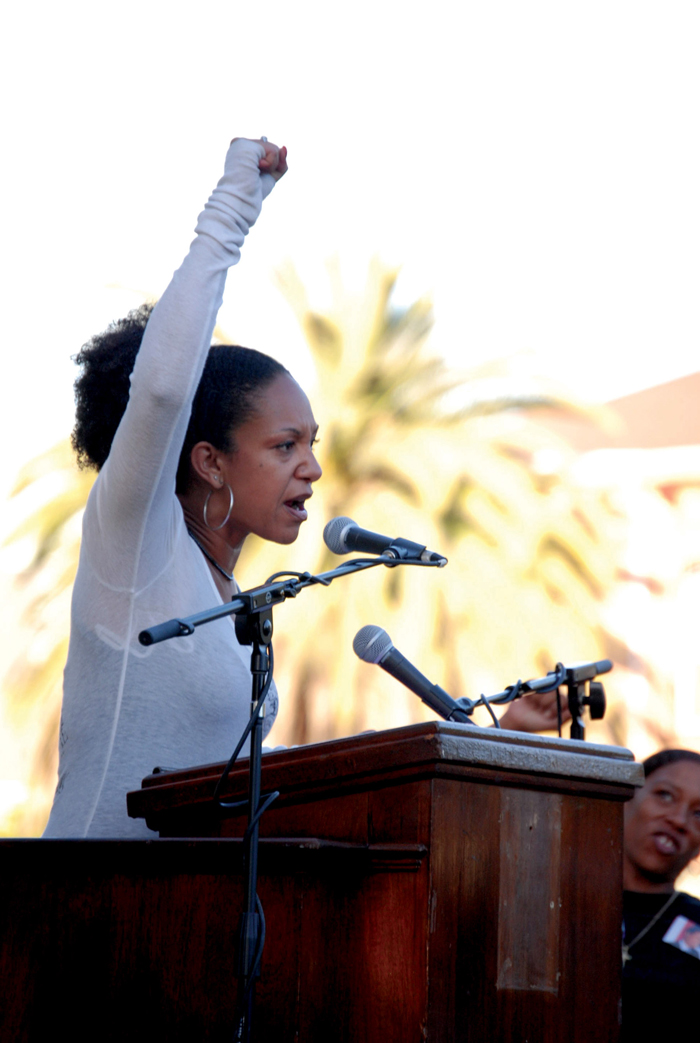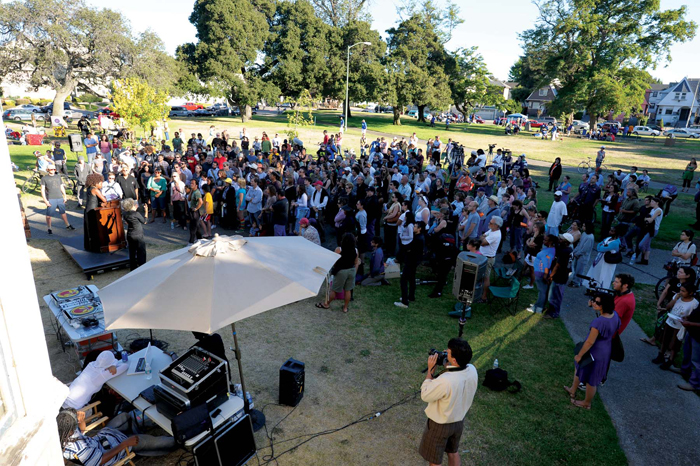
Sheilagh Brooks delivering speech for mark tribe’s The Liberation of Our People: Angela Davis 1969/2008. Defremery Park, 0akland, CA, August 2, 2008.
On November 12, 1969, journalist Seymour Hersh broke a story about the torture and murder of hundreds of South Vietnamese civilians by U.S. soldiers. Released in a cable filed by the Dispatch News Service, over 30 newspapers across the nation quickly picked up the story of the My Lai Massacre. The story was accompanied, in some cases, by images of death-strewn landscapes. One of the images—recorded by army photographer Ronald L. Haeberle—was borrowed by an informal cadre of artists associated with the Art Workers Coalition (AWC) in New York. The image was printed as a poster and overlaid with blood-red text, which simply read “Q. And babies? A. And babies.” (The text was excerpted from a CBS radio interview by Mike Wallace with Paul Meadlo, one of the soldiers involved.) The posters were to be produced by the Museum of Modern Art, but when the museum withdrew its support the AWC printed them anyway and distributed them during a demonstration in front of Pablo Picasso’s Guernica (1937), on view at MoMA.
Also on November 12, 1969, UCLA professor and soon-to-be iconic Black Panther Angela Davis gave a public address against the Vietnam War and the U.S. war machine at a public park in West Oakland, California. She warned of fascist tendencies in the federal government and insisted that the anti-war movement make the connection between international and domestic forms of oppression. Davis’s original speech was recorded but not widely distributed.
Almost 40 years later, in the summer of 2008, artist Mark Tribe organized a reenactment of Davis’s speech on its original site as the fifth in his six-part Port Huron Project. The project borrowed its name from a famous statement written by the Students for a Democratic Society, and included reenactments of speeches by activists Howard Zinn, Stokely Carmichael and César Chávez. The Davis speech was delivered by two performers: dancer Aleta Hayes and Stanford professor Sheilagh Brooks, an actor and community organizer. The event was coordinated by the Oakland Museum and produced under the auspices of Creative Time’s pre-election series of public art projects titled “Democracy in America: The National Campaign,” which broadly developed conversations with “cultural producers who consider their work activist.”
Historical reenactments recorded in film/video have become familiar tropes in contemporary art, most notably with Jeremy Deller’s Battle of Orgreave (2002), Pierre Huyghe’s Third Memory (1999), and Artur Zmijewski’s Repetition (2005). Deller enacted a full-scale recreation of an English coal-miners’ strike from 1984, involving laborers from the actual event. Huyghe investigated the original memory of the perpetrator of a bank robbery—reclaimed from Hollywood’s interpretation in Dog Day Afternoon (Dir. Sidney Lumet, 1975). And Zmijewski re-performed the famous Stanford Prison Experiment, which brought out the worst in students playing guards and prisoners, subsequently making experiments like it illegal in the u.S. All three examples radically mutate the more familiar, un-ironic historical reenactment staged by amateur civil war societies into complex frameworks of meaning with greater tensions and implications.
Mark Tribe’s more straightforward, near-verbatim approach to reenactment is analogous to a television-style dramatization. He hires actors who resemble the original speakers and stages the filming on the original locations. Tribe’s direct quotation, while interpreted by the actors, is more closely related to the AWC poster than the divergent reenactment strategies of the artists mentioned above. And like the AWC he has a specific agenda. Tribe reenacts speeches to amplify the echo of history and address problems of the present. He looks at Vietnam to talk about Iraq and insists on the continued relevance of Davis’s polemic. One can also surmise an interest in reviving the public life of lesser-known knowledge objects—in this case the stirring public provocations of the new left—through their free and widespread distribution on the Internet. This impulse on behalf of the intellectual commonwealth is one that overlaps neatly with the artist’s desire for increased visibility of his project. During a recent studio-visit with Tribe, he pointed me to the media theory of Yippie Jerry Rubin, who wrote in 1970: “You can’t be a revolutionary today without a television set [or in 2009 terms: a Web browser]. It’s as important as a gun! …Demonstrations last hours, and most of the time nothing happens. After the demonstration we rush home for the six o’clock news. The drama review. TV packs all the action into two minutes—a commercial for the revolution.”1

Crowd and cameras assembled at Defremery Park, Oakland, CA, for The Liberation of Our People: Angela Davis 1969/2008, august 2, 2008.
Tribe’s background as the founder of Rhizome.org and his work as a media studies professor at Brown University have enabled him to conceptualize and apply this approach to worldwide media. Tribe’s video of the Davis speech is available on YouTube and Vimeo. It’s available for download from the Internet Archive, and a transcription of the original speech is available on the Brown University wiki page. The reenactment event that took place last summer in Defremery Park in Oakland, however, was less considered and perhaps less considerate.
In his introduction to the performances, Tribe spoke to day-trippers who had landed awkwardly in a foreign corner of the city, urging us to assemble in view of the multiple video cameras set up to film the crowd as well as the speakers. He spoke to the group’s reluctance with assurances that the video would be seen quite a lot, implying that the service we were providing as extras would be worth the trouble. If we were lucky our faces would flash across the giant screen in Times Square, where the film was scheduled to appear. Any suspension of disbelief, any imagining of the historic moment and Davis’s message, was disrupted in the swarm of stagecraft. One is forced to assume that Tribe was privileging the media representation, the “commercial for the revolution,” over the live performance experience.
However, looking at the views of the Davis reenactment video on YouTube, the media outlet that now rivals any major TV network’s dominance, the count is only 330 (as of this writing), only slightly more than the crowd at the original event. If Tribe’s aim is in part to reconstitute the memory of the original speech by distributing its representation on the Internet, then why is the 20-minute video chopped down to only 5 minutes? These minor problems with the handling of his project lead back to concerns about the content of Davis’s speech when projected onto the Iraq war, which stir up larger questions about how history repeats and the project’s political viability.
In 2003, an activist organization called Voices, led by Howard Zinn and Anthony Arnove, began organizing reenactment-like performances to “bring to life” their political speech anthology Voices of a People’s History of the United States (HarperCollins, 2003). Aided by a team of “activists, artists and educators,” Zinn and Arnove invited famous actors such as Viggo Mortensen, Danny Glover, Marisa Tomei, Mark Ruffalo, Mos Def, and Robert Redford to read orations across two centuries—from Frederick Douglass (1852) to Cindy Sheehan (2005). The strategy, here deployed by committed activists, and the goal of increased visibility for radical proposals and resurrecting the rhetoric of liberal visionaries overlaps with Tribe’s project, affording it some legitimacy. And although one of Davis’s speeches “Political Prisoners, Prisons, and Black liberation,” is included in the anthology, no performance of this speech from 1970 has been recorded in six years of events by Voices.
Almost 40 years after his story about My Lai, Seymour Hersh was one of the first journalists to call public attention to another abuse of military power, this time at Abu Ghraib. While one occurred in the villages of Vietnam and the other took place in a Baghdad prison, both incidents played critical roles in building the anti-war sentiment in the U.S. In the words of Angela Davis, “We have to talk about what’s happening in Vietnam as being a symptom of something that’s happening all over the world…” She was warning us of the pervasive and longstanding “war economy” in the U.S. government, one that shapes our society, and is still visible in various forms of oppression here and abroad. Davis’s demands may not echo with fidelity, but the war machine lives on.
Joseph Del Pesco is an independent curator and occasional critic living in Oakland, California.
